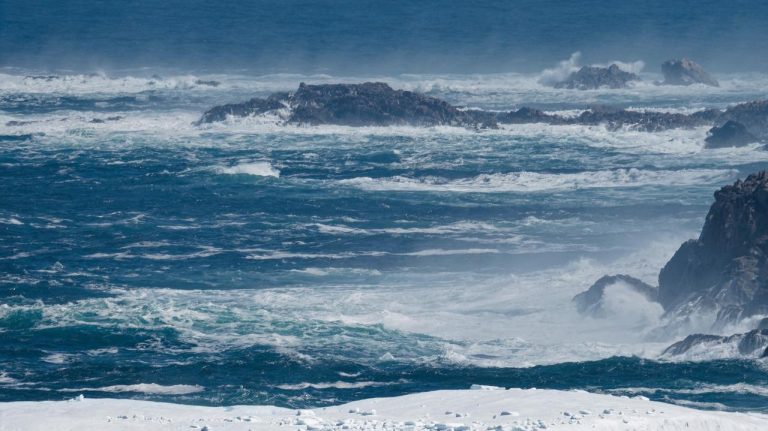Scientists have warned of the danger of radical changes in the circulation of the ocean in the Atlantic. It could cause climate disruption on a scale never seen before.
The 44 authors of the letter sent to the Nordic Council of Ministers include Professor Michael Mann of the US, who has contributed to the scientific understanding of historical climate change based on temperature data from the past thousand years. This letter was also signed by the German oceanographer Professor Stefan Rahmstorf, who specializes in researching the relationship between climate and ocean circulation. Climate scientists have been warning for years that global warming could seriously alter currents in the North Atlantic, but this is the first time they have directly warned governments.
Violation of the AMOC cycle
Ocean currents are caused by differences in temperature, salinity and density of water in the oceans. The water heated near the equator flows towards the pole, cools on the way, and then its high salinity and density causes it to fall lower, and it returns to the equator, where it warms up again. This makes it cooler at the equator and warmer at the polar regions. For this mechanism to work effectively, a difference in water temperature and salinity is necessary. If the transport of heat by ocean currents is stopped, the polar regions will become dangerously warm and the equatorial regions will become hotter. Greenhouse gas emissions increase the average global temperature. Then more fresh water flows into the Atlantic (from melting glaciers, especially in Greenland, and because of heavy rainfall). Increased freshwater input may cause the Atlantic Meridional Circulation (AMOC) to “shut down”. As the authors write, a number of scientific studies conducted over the past few years show that this risk is still largely underestimated. Such a change in the circulation of the ocean will have devastating and irreversible consequences, especially for the Northern countries, but also for other parts of the world. A growing body of evidence shows that the Arctic region is important for global climate regulation. The Greenland Ice Sheet, Barents Sea ice, boreal permafrost systems, the Subpolar Deep Sea Circulation, and the Atlantic Meridional Circulation (AMOC) are vulnerable to large-scale correlated and nonlinear changes. The AMOC, which is the dominant northward heat transport mechanism in the North Atlantic, determines the conditions of life for all people in the Arctic region and beyond, and is increasingly in danger of tipping over. Researchers report that the risk of passing the critical point is real. The average global temperature can rise much faster than 2.5 degrees. Thus, the goal of the Paris Agreement to limit global warming to 2 degrees and keep it at 1.5 degrees will not be implemented.
We may reach a tipping point within the next few decades
The Intergovernmental Panel on Climate Change (IPCC) 2023 report concluded with overwhelming certainty that the likelihood of abrupt or irreversible changes in the climate system will increase with global warming; the probability of previously rare occurrences associated with potentially very large adverse effects also increases. A recent report by the Organization for Economic Co-operation and Development (OECD) concluded that “current scientific evidence clearly supports unprecedented, urgent and ambitious climate action to address the risks of climate system disruption.” In 2023, the IPCC hoped that the Atlantic gyre would not be disrupted significantly by 2100 – but if it did, it would likely “cause abrupt changes in regional weather and have serious impacts on ecosystems and human activities”. Studies since the last IPCC report show that this risk was previously underestimated and may lose its upward trend over the next few decades. However, despite considerable research in this area, the probability of such an event remains highly uncertain. The authors of the open letter want to draw attention to the fact that the possibility of a collapse of the AMOC cycle remains open this century. It is more likely that the collapse will occur in this century, but will not be fully developed until the next century. Therefore, this threat should be taken seriously. Even the average probability of catastrophic events affecting the entire world over the next few centuries requires much more to be done to reduce the risks.
Global WarmingPAP/Maciej Zieliński
Severe weather conditions
For the Nordic countries, the consequences are likely to be catastrophic, including significant cooling in the region while surrounding regions warm. This will widen and deepen the “cold spot” that has already formed over the sub-Atlantic Ocean. This is likely to lead to unprecedented extreme weather conditions. Although the impact on weather patterns, ecosystems and human activities requires further study, the changes are likely to threaten agriculture in northwestern Europe. Many further impacts are likely to be felt globally, including tropical changes in tropical rainfall, reduced absorption of carbon dioxide by the oceans (and therefore faster increases in atmospheric carbon dioxide), and significant additional sea-level rise. , especially along the US Atlantic Coast and the “impact” on marine ecosystems and fisheries. Acknowledging that it is impossible to adapt to such a major climate disaster, the authors call on the Nordic Council of Ministers to begin assessing this significant risk for the Nordic countries and to take measures to minimize this risk. This could include using the strong international position of the Nordic countries to press for greater urgency and priority in global efforts to reduce emissions as quickly and as quickly as possible to the 1.5C target set out in the Paris Agreement. .
Climate change and its consequences in the world PAP/Adam Ziemienowicz, Maciej Zieliński
Main image source: Shutterstock

